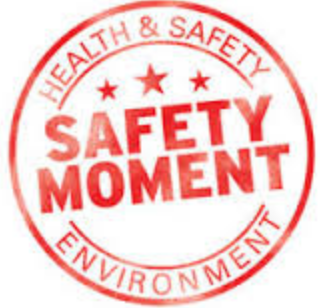Understanding Safety Moments: Definition, Significance, and Applications
Safety moments are brief, focused discussions or presentations that aim to raise awareness, promote safety consciousness, and reinforce safe behaviors in various settings. Despite their widespread use in industries such as construction, manufacturing, and healthcare, a clear understanding of safety moments and their significance remains elusive. This scholarly article explores the concept of safety moments, defines their key characteristics, discusses their significance in promoting safety culture, and examines their applications across different sectors. By synthesizing existing literature and drawing on real-world examples, this article provides valuable insights into the role of safety moments in enhancing safety performance and reducing workplace incidents.

Introduction To Safety Moments, What They Are
Safety moments, also known as safety talks, toolbox talks, or safety huddles, are short, focused discussions that address specific safety topics or issues within a workplace or community setting. These moments serve as opportunities to reinforce safe behaviors, highlight potential hazards, and share relevant safety information among individuals or groups. Despite their brevity, safety moments play a crucial role in fostering a strong safety culture and preventing workplace incidents. This article aims to provide a comprehensive overview of safety moments, including their definition, significance, and applications, to enhance understanding and promote their effective implementation in various contexts.
Definition of Safety Moments
Safety moments can be defined as concise, targeted presentations or discussions that focus on a particular safety topic, issue, or observation. These moments typically last for a few minutes and are intended to capture the attention of participants, impart important safety information, and encourage active engagement in safety-related discussions. Safety moments can take various forms, including verbal presentations, written materials, multimedia presentations, or interactive discussions, depending on the preferences and requirements of the audience and the context in which they are delivered.
Significance of Safety Moments
Safety moments play a crucial role in promoting safety awareness, reinforcing safe behaviors, and cultivating a strong safety culture within organizations. By providing regular opportunities for safety communication and education, safety moments help to keep safety at the forefront of employees' minds and encourage proactive safety practices. Moreover, safety moments empower employees to actively participate in safety initiatives, voice their concerns, and contribute to the continuous improvement of safety processes and procedures. Ultimately, the significance of safety moments lies in their ability to create a shared commitment to safety, reduce workplace incidents, and enhance overall safety performance.
Applications of Safety Moments
Safety moments find applications across a wide range of industries and settings, including construction, manufacturing, healthcare, transportation, and beyond. In the construction industry, for example, safety moments are commonly used to address specific hazards or risks associated with tasks such as working at heights, operating heavy machinery, or handling hazardous materials. In healthcare settings, safety moments may focus on topics such as patient safety, infection control, or medication administration protocols. Regardless of the industry or context, the key to effective safety moments lies in tailoring the content to address relevant safety issues, engaging participants in meaningful discussions, and fostering a culture of safety ownership and accountability.
Implementing Safety Moments: Best Practices and Strategies
- Identify Relevant Topics: Begin by identifying relevant safety topics or issues that are pertinent to the workplace or community. Consider factors such as current safety trends, recent incidents or near misses, regulatory requirements, and specific hazards associated with job tasks or activities.
- Tailor Content to Audience: Customize safety moment content to the needs, interests, and preferences of the target audience. Use language, examples, and visuals that resonate with participants and make the safety messages relatable and accessible.
- Keep It Concise and Focused: Safety moments should be brief and focused, typically lasting no more than 5-10 minutes. Choose a single safety topic or message to convey during each moment to ensure clarity and effectiveness.
- Encourage Active Participation: Foster active participation and engagement during safety moments by encouraging questions, discussions, and sharing of personal experiences or insights related to the topic at hand. Create a supportive environment where participants feel comfortable contributing to the conversation.
- Use Varied Delivery Methods: Employ a variety of delivery methods and formats to keep safety moments engaging and dynamic. Consider using multimedia presentations, interactive activities, real-life scenarios, role-playing exercises, or guest speakers to enhance interest and participation.
- Schedule Regular Sessions: Establish a regular schedule for safety moments to ensure consistency and continuity in safety communication efforts. Whether it's daily, weekly, or monthly, having predictable and recurring safety moment sessions helps to reinforce safety messages and keep safety top of mind for participants.
- Provide Training and Resources: Equip safety moment facilitators with the necessary training, tools, and resources to deliver effective safety moments. Offer guidance on facilitation techniques, presentation skills, and effective communication strategies to ensure that safety moments are delivered confidently and professionally.
- Evaluate and Adapt: Continuously evaluate the effectiveness of safety moments by soliciting feedback from participants, monitoring safety performance metrics, and assessing changes in safety attitudes and behaviors. Use this feedback to refine and improve future safety moment sessions and adapt content to address emerging safety concerns or priorities.
Finishing up, Safety Moments Summarized
In conclusion, safety moments serve as invaluable tools for promoting safety awareness, reinforcing safe behaviors, and fostering a strong safety culture within organizations. By providing regular opportunities for safety communication and education, safety moments empower individuals to take an active role in ensuring their own safety and the safety of those around them. Moving forward, it is essential for organizations to recognize the importance of safety moments and prioritize their effective implementation as part of comprehensive safety management strategies. Through ongoing commitment to safety moments, organizations can achieve significant improvements in safety performance, reduce workplace incidents, and create safer and healthier work environments for all.
